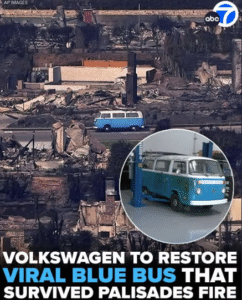Volkswagen has announced plans to restore a beloved blue VW Bus that remarkably survived the devastating Palisades Fire in California. The van, which became a viral symbol of resilience and nostalgia after images of it emerged charred but intact amid a scorched landscape, has captured the hearts of VW fans and the public alike. Now, the iconic automaker is stepping in to bring it back to life.
The 1970s-era VW Type 2 microbus, known for its vibrant baby blue paint and retro design, belonged to a local resident whose property was nearly consumed by the 2021 Palisades Fire. While many structures and vehicles in the fire’s path were completely destroyed, the bus managed to survive with only surface damage and singed paint—its body still largely intact. Photographs of the van parked stoically among blackened trees and ash went viral on social media, quickly turning it into an unexpected symbol of endurance.
In a recent statement, Volkswagen of America shared that the company was deeply moved by the story of the van’s survival and the emotional connection it sparked with people worldwide. “This bus is more than a vehicle. It’s a symbol of memories, road trips, and personal history,” said a VW spokesperson. “We felt a responsibility to honor that by restoring it to its former glory.”
The restoration project will be handled by Volkswagen’s heritage division in collaboration with specialists from their Classic Division in Germany. According to the plan, the team will fully disassemble the bus, address any fire-related damage, and meticulously restore the interior, exterior, and engine to original factory specifications. The goal is not just cosmetic restoration, but full mechanical functionality, allowing the van to return to the road as a drivable piece of history.
The owner of the bus, who asked not to be named, shared his gratitude in a brief interview. “This van has been in my family for decades. My kids grew up riding in it, and we’ve taken it on more road trips than I can count. I was heartbroken after the fire, even though it somehow survived. What Volkswagen is doing… it means the world to me.”
The Palisades Fire burned over 1,200 acres in May 2021 and prompted evacuations across several neighborhoods in the Pacific Palisades area of Los Angeles. The cause of the fire remains under investigation, but officials at the time described extreme fire behavior and high winds that made the blaze difficult to control. The blue VW Bus stood out in the aftermath as a rare survivor amidst widespread destruction.
Volkswagen’s decision to restore the van has resonated strongly with enthusiasts of the brand. On forums and social media, fans are praising the company for recognizing the emotional significance of the vehicle and stepping in to preserve an important part of automotive and cultural history. The VW Bus, often referred to as the “hippie van,” holds a special place in the hearts of many due to its connection with the counterculture movement, freedom of travel, and family adventures across generations.
Restoration work is expected to take several months, with regular updates promised via Volkswagen’s social media channels and a dedicated microsite. The project aims to showcase not only the craftsmanship involved in restoring such a vehicle, but also to highlight the brand’s commitment to its heritage and loyal customer base. When completed, the bus will be displayed at various automotive events and possibly featured in Volkswagen’s heritage museum in Wolfsburg, Germany.
Interestingly, the restoration also aligns with Volkswagen’s broader efforts to celebrate the legacy of the VW Bus while pushing toward the future. The company has been promoting the all-electric ID. Buzz, a modern reinterpretation of the classic microbus, as a key part of its electric vehicle strategy. The viral story of the Palisades survivor provides a unique opportunity to bridge the brand’s nostalgic past with its forward-looking innovations.
Some industry analysts note that this kind of high-profile, emotional restoration helps humanize the brand and reinforces consumer loyalty at a time when automakers face intense competition and scrutiny. “This isn’t just marketing,” said one analyst. “It’s storytelling. It’s authenticity. And it taps into a cultural memory that transcends generations.”
Volkswagen has a long history of supporting restoration efforts for classic vehicles. Their Classic Division routinely assists with parts, expertise, and full restorations of vintage models across Europe and North America. However, few restoration stories have captured the public’s imagination quite like this one. The image of the blue VW Bus, battle-scarred yet standing, is likely to remain an enduring symbol for the brand and its community.
The van’s restoration is also drawing attention from documentary filmmakers, with rumors circulating that a short film or series could be in development to chronicle the process from start to finish. If confirmed, such a project would offer fans a behind-the-scenes look at the craftsmanship, emotion, and technical know-how that goes into bringing a beloved vehicle back to life.
For now, the bus remains in the care of restoration experts, who are carefully preserving any unique markings left by the fire while returning the van to roadworthy condition. Volkswagen has emphasized that the restoration will honor the van’s past and the memories it holds, while ensuring it can continue creating new ones well into the future.
As one VW fan wrote on Instagram, “It’s more than metal. It’s a story. And I’m so glad that story isn’t over yet.”


